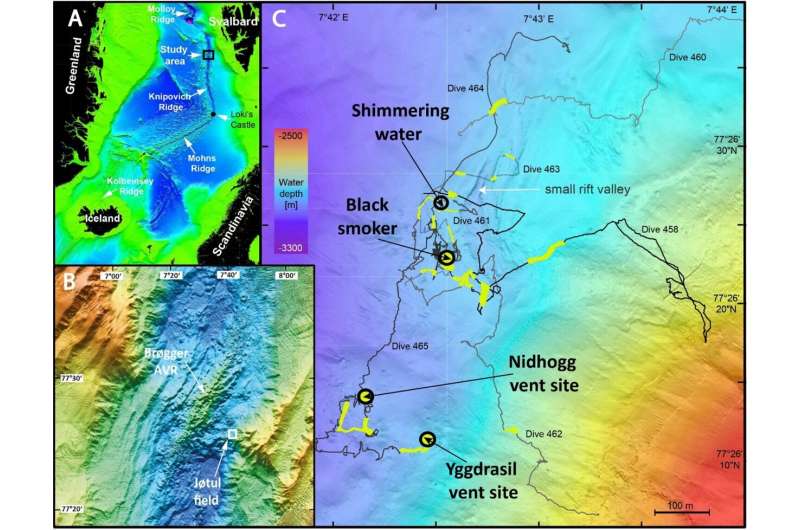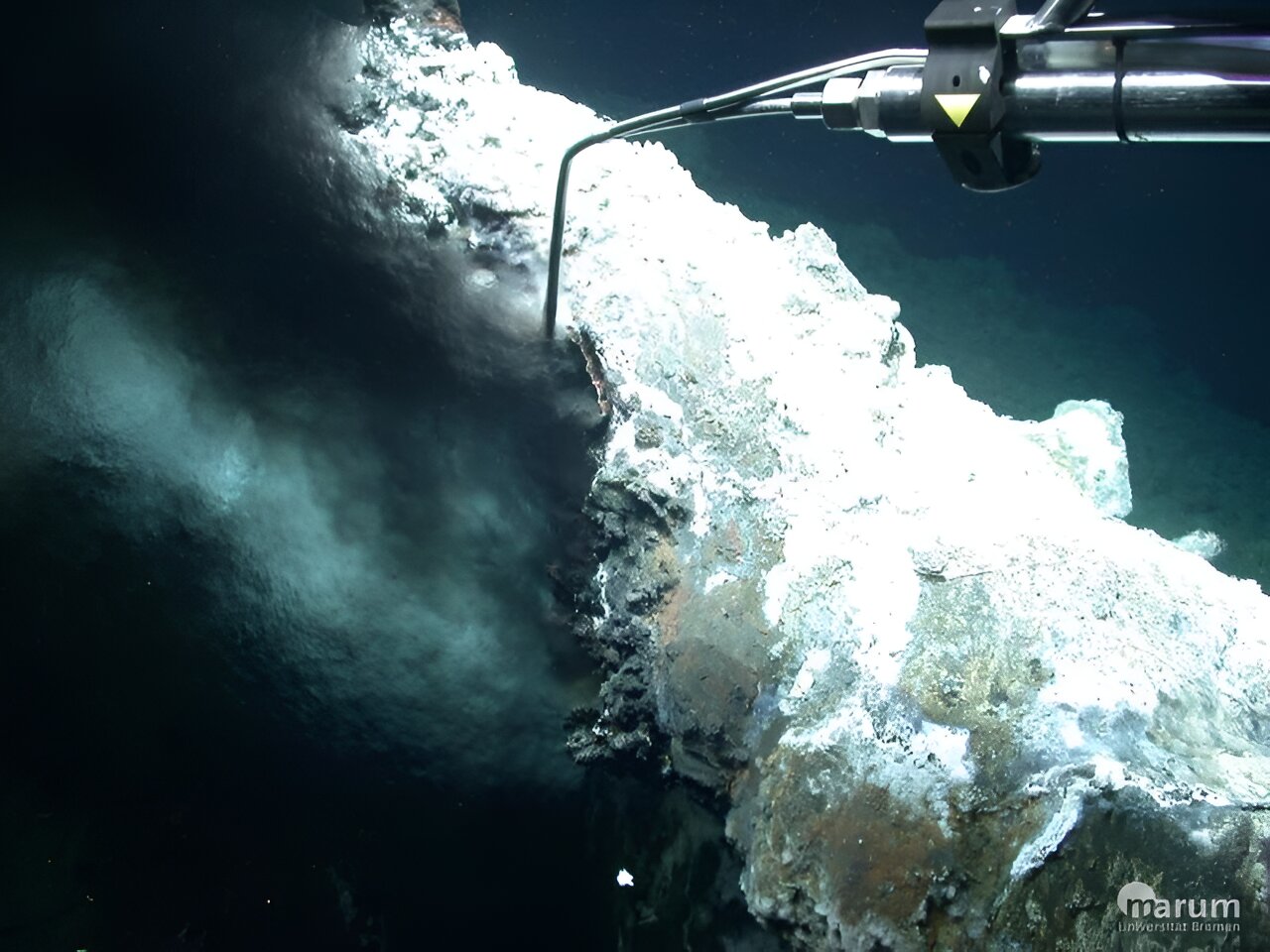The temperature reading at the outlet of the black smoker showed fluid temperatures in excess of 300°C. Credit: University of Bremen
Hydrothermal vents are found all over the world at the intersections of floating tectonic plates. But there are still many hydrothermal fields yet to be discovered. During a 2022 MARIA S. MERIAN expedition, the first field of hydrothermal vents was discovered on the 500-kilometer-long Knipovich Ridge off the coast of Spitsbergen.
An international team of researchers from Bremen and Norway, led by Prof. Dr. Gerhard Bohrmann from MARUM—Center for Marine Environmental Sciences and the Department of Geosciences at the University of Bremen, now reports on the discovery in the journal Scientific reports.
Hydrothermal vents are leaks on the seabed from which hot fluids escape. “Water penetrates the ocean floor where it is heated by magma. The superheated water then rises back to the sea floor through cracks and crevices. On its way up, the fluid is enriched with minerals and materials dissolved from the oceanic crust rocks. These fluids often seep back onto the seabed through tubular chimneys called black smokers, where metal-rich minerals are then precipitated,” explains Prof. Gerhard Bohrmann from MARUM and chief scientist of the MARIA S. MERIAN (MSM 109) expedition.
At water depths of over 3,000 meters, the remotely operated underwater vehicle MARUM-QUEST took samples from the newly discovered hydrothermal field. The field is named after Jøtul, a giant from Norse mythology, and is located on the 500-kilometer-long Knipovich Ridge.
The ridge lies within the triangle formed by Greenland, Norway and Spitsbergen on the boundary of the North American and European tectonic plates. This type of plate boundary, where two plates are moving apart, is called a spreading boundary.
The Jøtul field is located on an extremely slowly spreading ridge with a plate growth rate of less than two centimeters per year. Because very little is known about hydrothermal activity on slowly spreading mountain ridges, the expedition focused on obtaining an overview of the escaping fluids, as well as the size and composition of active and inactive smokers in the field.

(A) Map of the Norwegian-Greenland Sea (GEBCO data) showing locations of active spreading centres on the seabed and the study area. (B) Detailed map of the study area (ship-based multibeam data acquired during cruise MSM109) including the Brøgger Axial Volcanic Ridge (AVR) and the newly discovered hydrothermally active area named Jøtul hydrothermal field. (C) AUV-based bathymetry of the Jøtul hydrothermal field (data acquired during cruise MSM109 and provided by the Norwegian Offshore Directorate). ROV dive tracks are shown and track sections, where hydrothermal activity was visually observed, are highlighted in yellow. Four locations were sampled for fluids during MSM109 and are indicated with circles. Credit: Scientific reports (2024). DOI: 10.1038/s41598-024-60802-3
“The Jøtul field is a discovery of scientific importance, not only because of its location in the ocean, but also because of its significance for the climate, which was revealed, among other things, by our detection of very high concentrations of methane in the liquid samples,” reports Gerard Bohrmann.
Methane emissions from hydrothermal vents indicate a strong interaction of magma with sediments. During its journey through the water column, a large part of the methane is converted to carbon dioxide, increasing the concentration of CO2 in the ocean and contributes to acidification, but also affects the climate as it interacts with the atmosphere.
The amount of methane from the Jøtul field that ultimately ends up directly in the atmosphere, where it then acts as a greenhouse gas, still needs to be further investigated. Little is also known about the organisms that live chemosynthetically in the Jøtul field. In the darkness of the deep ocean, where photosynthesis cannot take place, hydrothermal fluids form the basis for chemosynthesis, which is used by very specific organisms in symbiosis with bacteria.
In order to significantly expand the somewhat scarce information available on the Jøtul field, a new expedition of the MARIA S. MERIAN will start in late summer of this year under the leadership of Gerhard Bohrmann. The focus of the expedition is to explore and sample still unknown areas of the Jøtul field. With extensive data from the Jøtul field, it will be possible to make comparisons with the few already known hydrothermal fields in the Arctic province, such as the Aurora field and Loki’s Castle.
The published study is part of the Bremen Cluster of Excellence “The Ocean Floor – Earth’s Uncharted Interface”, which investigates complex processes on the seabed and their impact on the global climate. The Jøtul field will also play an important role as an object of future research in the cluster.
More information:
Gerhard Bohrmann et al., Discovery of the first hydrothermal field along the 500 km long Knipovich Ridge off the coast of Spitsbergen (the Jøtul field), Scientific reports (2024). DOI: 10.1038/s41598-024-60802-3
Offered by the University of Bremen
Quote: Investigation of recently discovered hydrothermal vents at a depth of 3,000 meters off the coast of Spitsbergen (2024, June 28) retrieved on June 28, 2024 from https://phys.org/news/2024-06-newly-hydrothermal-vents- depths-meters.html
This document is subject to copyright. Except for fair dealing for private study or research, no part may be reproduced without written permission. The contents are supplied for information purposes only.
